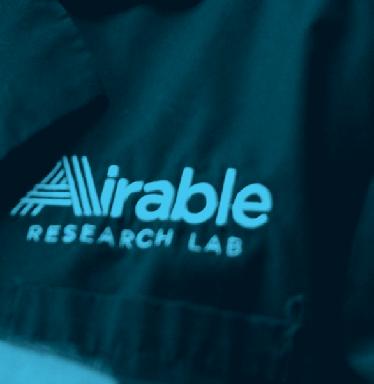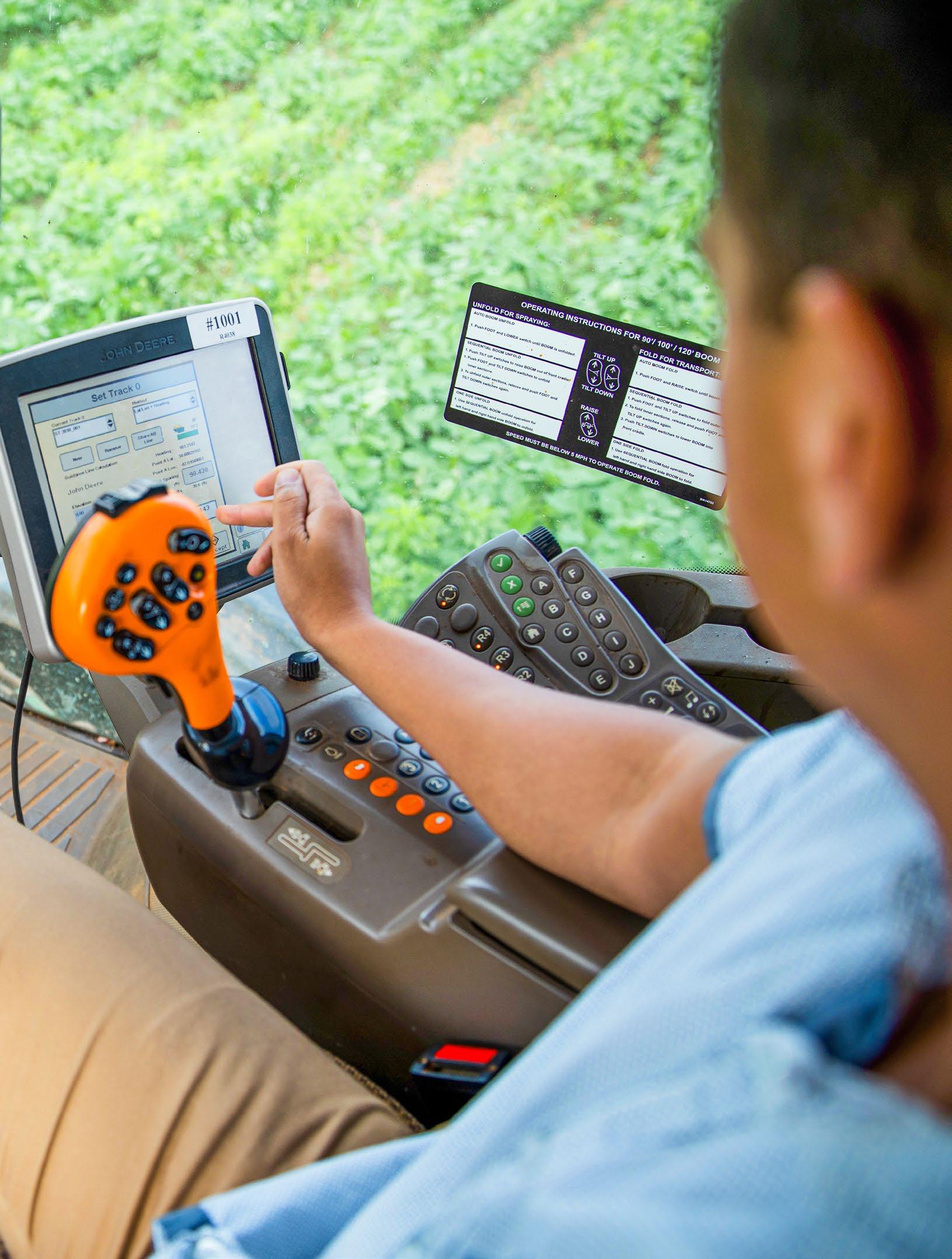




Whether shipping by river, road or rail, the soy checkoff is committed to ensuring America’s infrastructure is a significant advantage for U.S. soybean farmers. We’re looking inside the bean, beyond the bushel and around the world to keep preference for U.S. soy strong. And it’s helping make a valuable impact for soybean farmers like you.
See more ways the soy checkoff is maximizing profit opportunities for soybean farmers at unitedsoybean.org





ARusty Goebel
Ohio Soybean Association President Williams County soybean farmer
s an Ohioan, I’m no stranger to political ads. Ohio has historically been a swing state, meaning that we are flooded with political ads, especially during presidential election years. I had already started to see ads for senate primary races back in December.
While these ads serve as a reminder to vote in the upcoming primary election, they also remind me that politicians’ time will be especially precious this year as they are on the road campaigning. Organizations that advocate on behalf of farmers and ag businesses like the Ohio Soybean Association (OSA) can maximize what little free time our elected officials will have this year. OSA, alongside the American Soybean Association, has a constant presence in Columbus and Washington, D.C., ensuring that even in an election year ag priorities don’t slip through the cracks.
I encourage you to take a look at all the policy work OSA is committed to accomplishing in 2024 (page 5). That’s because our staff and board members work tirelessly to promote and protect the soybean industry. You can see a full list of the benefits you receive as an OSA member on page 6, but in my mind the most important benefit you get is representation in front of elected officials that delivers real results to the farming community.
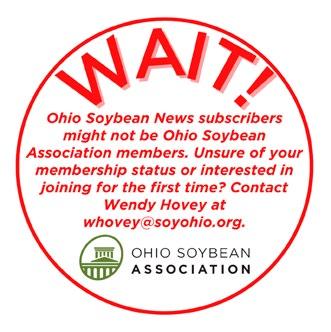
The Ohio Presidential Primary election will take place on March 19. This election is important as Ohioans help select the candidates for our next president, but there are also issues and candidates at the state and local levels that are significant for your community and farming business. Make sure you have a plan to vote on March 19, and if you’ve missed the deadline to register for the primary election, make sure you do so by October 7 for November’s general election.
While you’re busy making planting preparations, we’ll be your voice at the Statehouse and on Capitol Hill.
Rusty Goebel
President
Rusty Goebel, Williams County
Vice President
Bennett Musselman, Pickaway County
Treasurer
Trish Cunningham, Union County
Secretary
Jeff Magyar, Ashtabula County
Chairman
Patrick Knouff, Shelby County
Trustees
David Clark, Warren County
Dustin Converse, Union County
Dave Green, Crawford County
Austin Heil, Hardin County
Scott Metzger, Ross County
Jeremy Price, Putnam County
Derek Reusser, Wayne County
Ryan Rhoades, Marion County
Andy Stickel, Wood County
Bob Suver, Clark County
Kerrick Wilson, Preble County
Jennifer Wilson-Oechsle, Van Wert County
American Soybean Association
Board Representatives
Rusty Goebel
Scott Metzger
Ryan Rhoades
Staff Credits
Kirk Merritt - Publisher
Julia Brown - Editor
Brent Warren - Art Director
Barry Falkner - Photo Quality/Proofer
Ohio Soybean News is published six times a year by the Ohio Soybean Association, 918 Proprietors Rd., Suite A, Worthington, OH 43085. Phone: 614-476-3100.
Comments and statewide news articles should be sent to the above address. Advertising space reservation must be made by the first of the month preceding publication. In consideration of the acceptance of advertisement, the agency and the advertiser must, in respect of the contents of the advertisement, indemnify and save the publisher harmless against any expense arising from claims or actions against the publisher because of the publication of the content of the advertisement.
For Advertising Sales Contact: Matt Herman - (612) 812-5833 matt.herman@dtn.com
For Address Corrections Contact: Ohio Soybean News at 918 Proprietors Rd., Suite A, Worthington, OH 43085.
Web address: www.soyohio.org
E-mail: cdeboard@soyohio.org

The Ohio General Assembly and Congress will both be meeting a limited number of days in 2024 due to election year activities. Despite the limited time to engage with lawmakers, the Ohio Soybean Association will be working hard to advocate key policies for its members. Property tax bills, including those under Current Agricultural Use Valuation (CAUV), in 41 of Ohio’s counties will be hitting mailboxes soon. Many landowners can expect to see increases in those tax rates. Even with the increases likely coming in 2024, CAUV still offers significant property tax savings for Ohio agricultural land over market value. In most years, CAUV values are about half of market value. The General Assembly’s Joint Committee on Property Tax Review and Reform will be meeting in 2024 to consider long-term changes to Ohio’s property tax system. OSA will be closely engaged in this process to evaluate new proposals that may change how property taxes work in Ohio and
further improve CAUV.
Other legislation being considered in 2024 includes a bill to clarify the ability of farmers to utilize Ohio’s agricultural sales tax exemption for the purchase of ATVs, UTVs, compact tractors and trailers used in farming operations. HB 347 would help clarify the law to eliminate confusion over this issue, and OSA is calling on lawmakers to pass it.
OSA will also be working to ensure Ohio maintains quality grain testing at elevators in the wake of a proposal, included in HB 238, to eliminate the certification of individuals who conduct grain testing as is currently required. In addition, we are closely watching a proposal dealing with local municipalities’ ability to regulate pesticide applications on private property.
In December, the OSA board conducted an in-depth review of tools available to local communities to avoid development sprawl and to preserve farmland. A new effort to advocate for better utilization of these
existing tools, such as establishing Agricultural Security Area that prohibit development on farmland, will be another priority in 2024.
At the federal level, the Ohio Soybean Association will be closely following developments around the next Farm Bill. The organization has been advocating for preserving crop insurance and promoting enhancements to key commodity support and trade programs for some time now. OSA will also be looking for opportunities to promote new markets through policies such as supporting the development of renewable fuels like biodiesel, renewable diesel, and sustainable aviation fuel from soybean feedstocks. There will also be more work around a concerning proposal from the U.S. EPA aimed to place new regulatory requirements on pesticide applicators. Members of the board of directors will take their message to Capitol Hill during two planned advocacy trips to Washington, D.C., in March and July this year. u
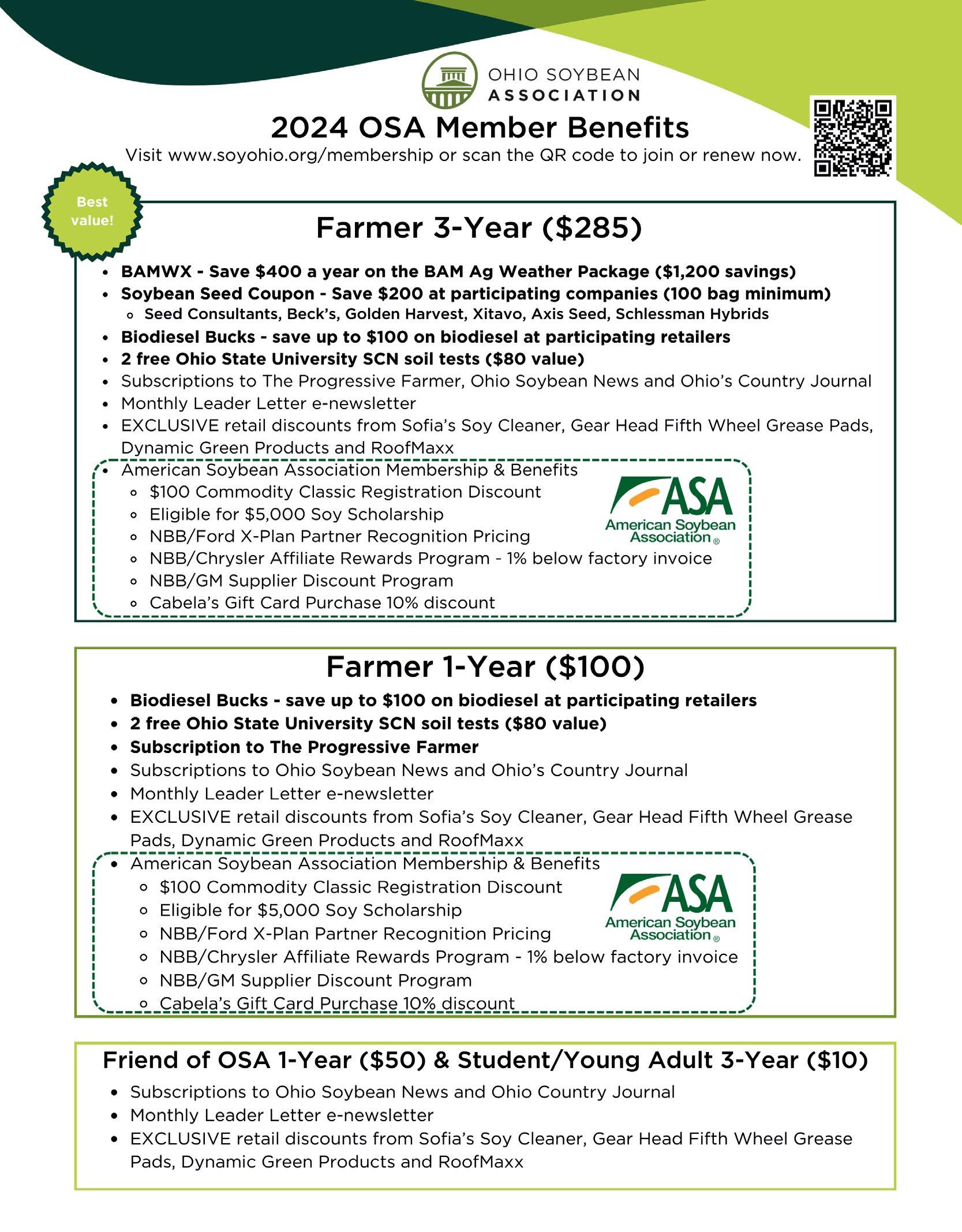



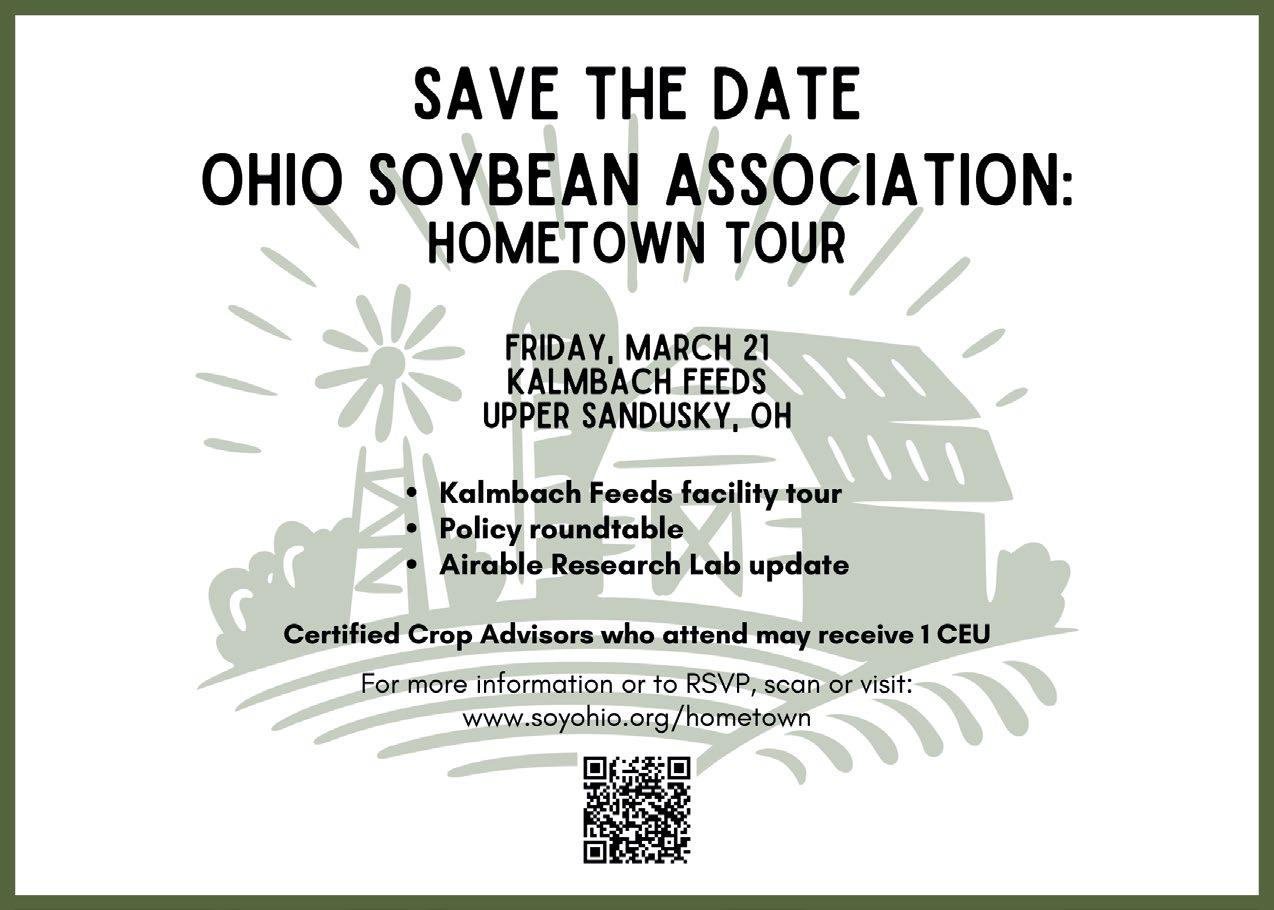
The Field Leader program from the Ohio Soybean Council and the soybean checko keeps you informed about the latest technologies, trends and research in the field, all in an e ort to keep your operation moving forward and to help you become a leader in your field.
how we

by


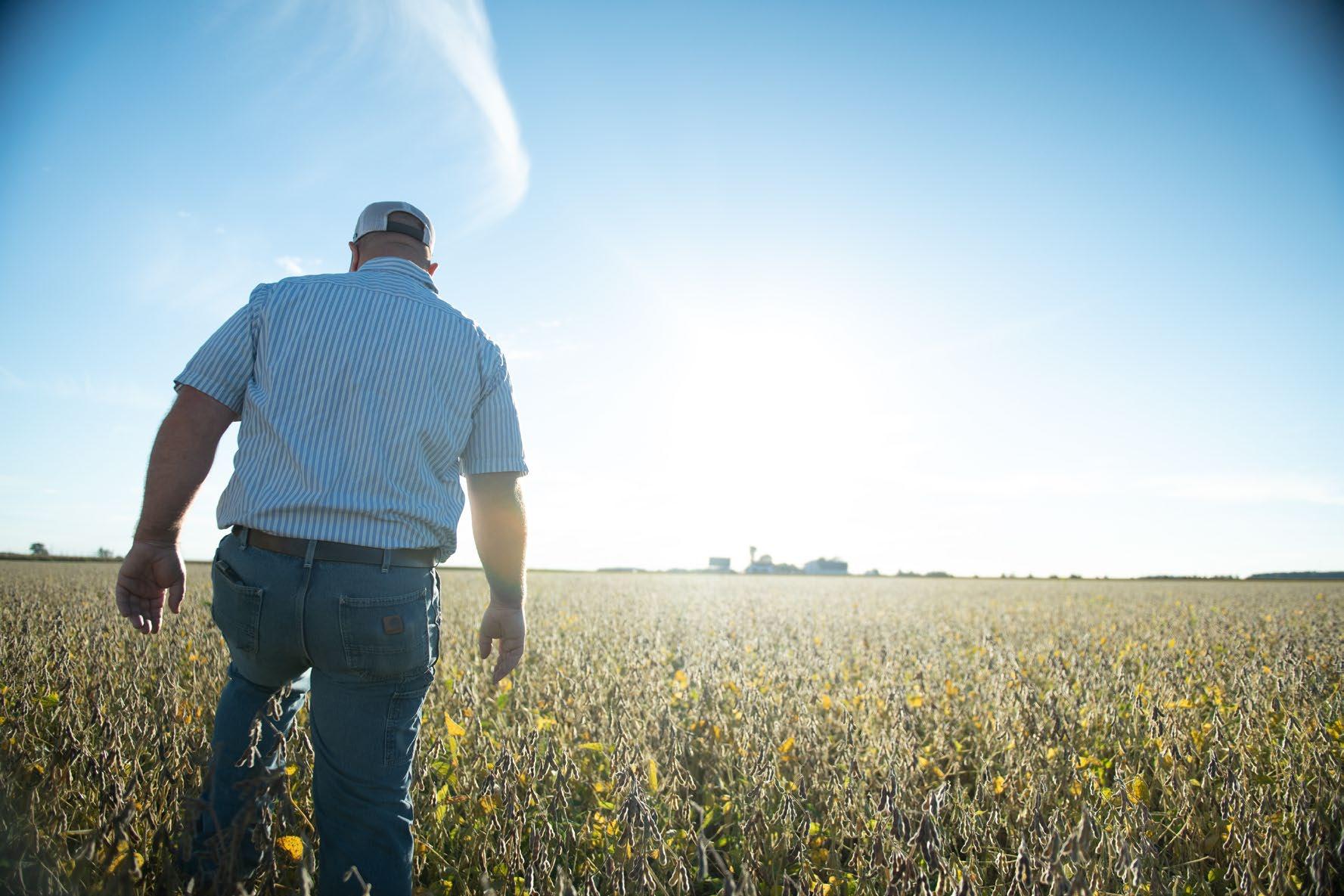

The developing and emerging nations of today are the home of tomorrow’s U.S. Soy customers



Placing a Premium on Detailed Documentation of Planting and Yield Data
Accurate in-field data adds off-farm value for Missouri farmer and crop insurance agent Joshlin Yoder on his family operation and for customers.
Whether it’s analyzing yield monitor data or as-applied maps of planting prescriptions, Joshlin Yoder has a diverse appreciation for the efficiency gains that come from collecting accurate farm information.
The third-generation farmer joined the 4,500-acre corn and soybean operation full-time in 2008, farming with his wife, Addie, father, Merlin, and brother, Jordan. Yoder has also carved out a successful career as a crop insurance agent, initially with a firm for 7 years and then his own business, Yoder Crop Insurance, established in 2021.
The family’s progressive investment in precision ag has allowed Yoder to broaden the benefits of detailed yield and acreage information to provide more accurate reporting for crop insurance.
Reporting Efficiency
When he started writing policies in 2014, Yoder says he didn’t have any customers who utilized farm data as part of their reporting. Most of the yield and acreage information he received was still based on notes farmers took during the season or their recollection of planting dates, seeding populations, and yield estimates.
While in-cab displays and yield monitors certainly weren’t new precision ag tools at the time, Yoder says one of the

Name: Joshlin Yoder
Farm: Yoder Farms
Location: Leonard, MO
Size: 4,500 acres
Crops Grown: Corn and Soybeans
Valuable Tech Tools: Libra Cart, Ag
Leader Technology SMS Advanced; InCommand 1200 monitor
Precision Pain Point: More efficient crop insurance reporting with collected ag data
limiting factors in using farm data for reliable crop insurance reporting was the meticulous yield calibration requirements.
“Even five years ago, consistently calibrating yield monitors was an obstacle to getting reliable yield information,” Yoder says. “It’s not that the reporting rules are any less stringent today, but the capabilities of the technology to capture better data has improved to be more automated and accurate.”
Yoder estimates that about onethird of his clients now utilize yield
monitor or grain cart data for crop insurance reporting, and as much as 50% submit acreage information based on planting data.
“We can take someone’s planting data and GPS data, plug it into the insurance reporting software and generate acres reports,” he says. “In most cases, it’s a far more efficient and accurate process.”
Yoder sees continued growth in the application of precision ag data in crop insurance reporting, and beyond. There are new geographic and crop-specific add-ons that farmers can add to their insurance policies and further reduce risk.
For example, a new USDA pilot program — Post Application Coverage Endorsement (PACE) — provides farmers who splitapply nitrogen with additional protection if weather prohibits them from making those secondary applications.
“There’s going to be some pretty stringent documentation requirements, and with the scope of application data collected today, this seems like an ideal scenario to utilize that information,” Yoder says. “Every year, crop insurance covers a specific event or scenario, and the documentation requirements won’t loosen up. But the advanced collection of precision data can give farmers an advantage and more easily and efficiently meet those requirement thresholds.”
For more profiles like this one or to read reviews of precision ag equipment, visit PrecisionAgReviews.com. u



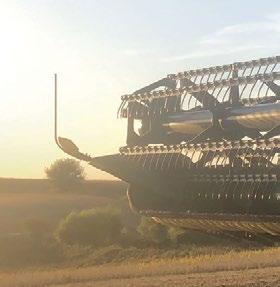



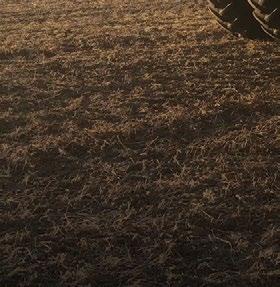






By Elizabeth Hawkins and John Fulton
The 2023 eFields report is now available. Each year, Ohio State University Extension partners with Ohio farmers to bring local research results to you through the eFields program. These results are summarized and published by the OSU Digital Ag Team in the eFields Report.
The 2023 eFields Research Report highlights 184 on-farm, field-scale trials conducted in 47 Ohio counties. Research topics for the 2023 report include nutrient management, precision crop management, cover crops, technology and forages. Other information about crop production budgets, planting progress, farm safety, and farm business analysis are also included.
For 2023, eFields soybean research was focused on improving the production and greater profitability of soybeans in the great Ohio area. Some exciting and innovating projects were executed this year, with 22 studies being conducted across the state.
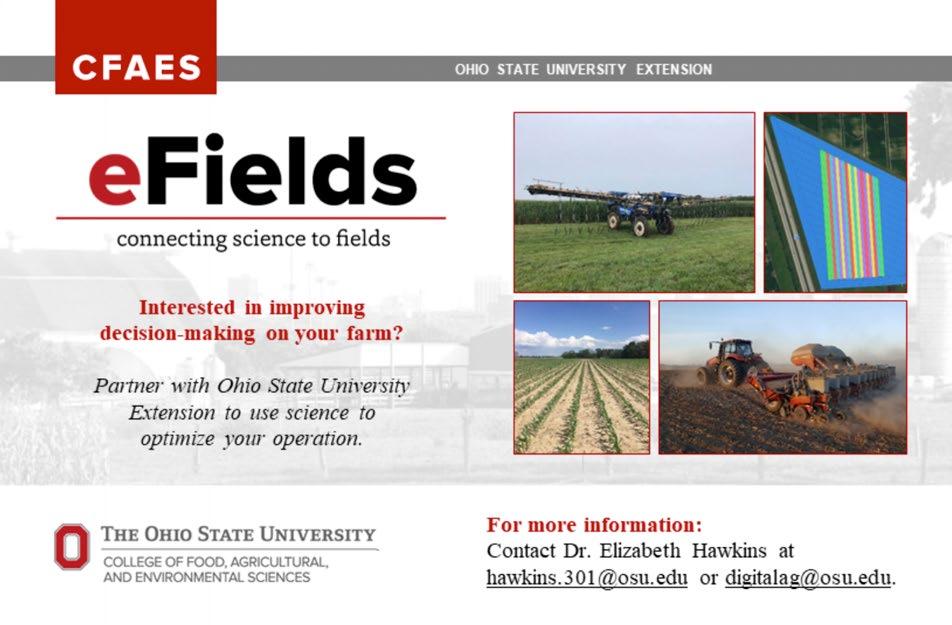
For more information: Contact Dr. Elizabeth Hawkins at hawkins.301@osu.edu or digitalag@osu.edu.

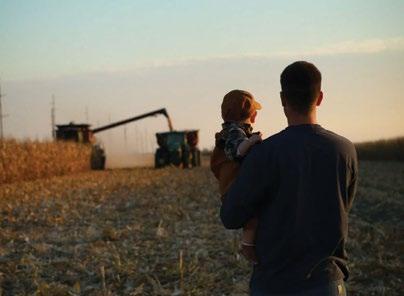

Soybean research presented in the 2023 eFields report covers both precision seeding and compaction management. The 22 soybean-specific studies took place on 587 acres.
Though not all of the soy-related research in eFields is checkofffunded, many Ohio Soybean
Council-backed projects made it into the report. Some of this research includes soybean cyst nematode, sudden death syndrome and a soil health survey across the state. We are always looking for new partners in on-farm research trials. If you are interested in becoming involved in research with the eFields program, contact your local county Agriculture & Natural Resources Extension Educator or the eFields staff directly Dr. Elizabeth Hawkins (hawkins.301@osu.edu) or Dara Barclay (barclay.67@osu.edu).
The 2023 report is now available in both a print and e-version. To receive a printed copy, contact your local OSU Extension office or email digitalag@osu.edu. The e-version can be viewed and downloaded at
go.osu.edu/eFields with the online version readable using a smartphone or tablet device.
We would like to sincerely thank all our 2023 collaborating farms and industry partners. The eFields team enjoys working with each of you and we are looking forward to continuing to learn together in 2024. Follow our social media using @OhioStatePA on Facebook, Twitter, and Instagram or subscribe to our quarterly newsletter, the Digital Ag Download (go.osu. edu/DigitalAgDownload), to keep up with the eFields program throughout the year. For more information on how to get involved in eFields during 2024, contact Elizabeth Hawkins at hawkins.301@osu.edu
Dr. John Fulton is a Professor in the Food, Agriculture and Biological Engineering Department at Ohio State University and can be reached at fulton.20@osu.edu. Dr. Elizabeth Hawkins is a Field Specialist for Ohio State University Extension and can be reached at hawkins.301@osu.edu. u
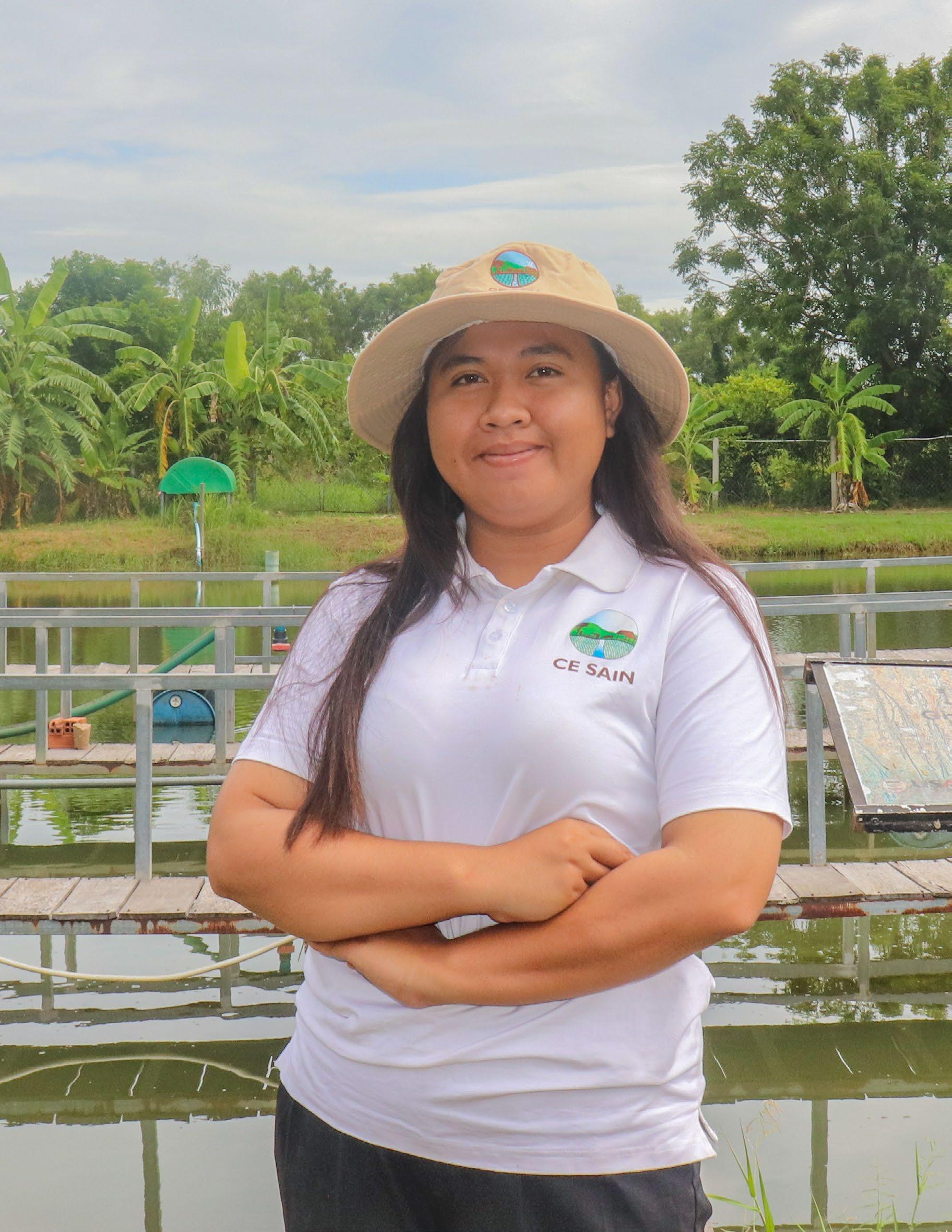

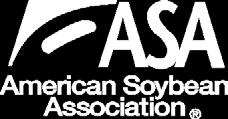

By Madi Layman, Manager of Demand & market Development
Panama has been used as a trade route since as early as 1513. Over the next four hundred years, traders transported merchandise by foot, river and rail across the isthmus between the Atlantic and Pacific Oceans. Today, the Panama Canal is a major trade route for US Soy, sending 600 million bushels through the system annually.
Last December, Ohio Soybean Council (OSC) farmer-board members David Clark, Chad Warner and Bill Bayliss along with staff members Kirk Merritt and Madi Layman visited the Panama Canal with the Soy Transportation Coalition (STC). The last time Ohio Soybean visited the Panama Canal was in 2015 when the Neopanamax locks were under construction. This time, the team visited the new, completed Aqua Clara Lock, original Miraflores Lock systems and the Port of Hutchinson.
“Our transportation systems have a huge impact on how, when and where our grain is moved,” says Clark, a farmer from Warren County. “Not just in local routes but in international. The Panama Canal is a key player in moving grains from the U.S. Gulf Coast to Asian regions — our largest export customers.”

Three features made Panama the ideal site for a canal system to connect the Pacific and Atlantic oceans: (1) natural river system, (2) narrow neck of land, and (3) abundant rainfall.
Before the canal system was built, traders traveled across the isthmus by foot via the Camino Real and water via the Chagres River. The Spanish Crown showed initial interest in connecting the two oceans, whether through Panama or Nicaragua. Other nations like France, England and the United States also took interest in discovering new routes.
In November 1903, Panama declared independence from Colombia. During that same month,
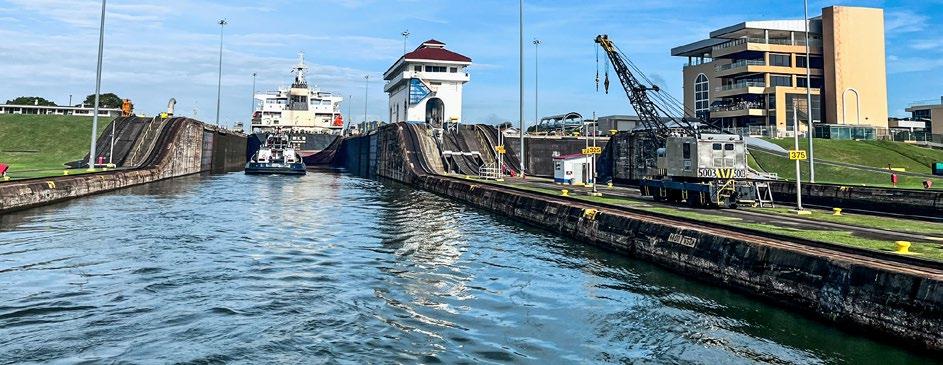
Last December, Ohio Soybean Council farmer-board members visited the Panama Canal with the Soy Transportation Coalition.
the United States and Panama signed a treaty that granted the U.S. the land, building, protection and management it needed to begin construction on the Panama Canal.
In 1906, the Chagres River was dammed to create Lake Gatún which sits 26 meters above sea level. Lake Gatún regulates water flow in the canal and provides drinking water to the country of Panama. The lock system was created to raise and lower ships from either the Atlantic or Pacific Oceans to the lake. The original system is made of twelve locks, six pairs of locks that allow vessels to move from the Atlantic to the Pacific and vice versa at the same time. The Panama Canal welcomed its inaugural voyage on August 15, 1914.
Over time, maritime traffic demands increased, and the lock system could not accommodate the larger Panamax vessels — New Panamax or Neopanamax. In 2006 the city of Panama approved a
proposal from the Panama Canal Authority (PCA) to construct new locks on the Atlantic and Pacific sides of the canal to service these new vessels. The locks welcomed the inaugural voyage on June 26, 2016. Panamax vessels carry up to 5,000 twenty-foot equivalent unit (TEU) containers and Neopanamax vessels carry up to 14,000.
The Panama Canal is 50 miles long and it takes ships about eight to ten hours to transit from ocean to ocean. The canal operates 24 hours a day, 365 days a year. Due to a prolonged dry season last year, the PCA is limiting the number of vessel trips to conserve water. Prior to restrictions, 36 vessels could travel the canal system daily. As of January 16, 2024, the PCA restricted transits to 24 vessels per day.
grain vessels leaving the U.S. Gulf for east Asia ports saw significant route shifts between November 19 and December 30. Due to the low water levels in the Panama Canal, 15 bulk vessels rerouted to the Suez Canal between November 16 and December 2. During that period, attacks began in the Red
grain inspections for export than west coast ports. Checkoff-funded data with IHS Markit shows that the U.S. Gulf and Atlantic ports account for nearly 95 percent of Ohio soybean product exports.

The Soy Transportation Coalition’s visit to the Panama Canal came at a time when there are several canalrelated supply chain disruptions. The low water levels in the Panama Canal and danger of transiting through the Suez Canal and Red Sea have forced vessels to take alternate routes that increase travel time, fuel usage and shipping costs.
According to USDA’s January 18 Grain Transportation Report, bulk
Sea. A major shift in routes was seen between Dec. 17 and Dec. 30 when 11 bulk grain vessels opted for the Cape of Good Hope — the southern tip of Africa — route as tensions remain high in the middle east and water levels remain low in Latin America.
The Cape of Good Hope is a 34-day transit from U.S. Gulf coast to east Asia. The Panama Canal is 20 days and Suez Canal is 31. West coast ports typically have a 11 to 12-day transit time. Despite this, the U.S. Gulf has seen nearly double the
The Ohio Soybean Council invests in projects with the STC to build reliable and efficient transportation routes, so soybeans farmers have access to international markets. The Soy Transportation Coalition and U.S. soybean farmers are monitoring the affects these supply chain disruptions have on American agriculture exports. Clark recently finished his third term as OSC’s representative on the STC board of directors. He gave input on STC projects involving investments in the Mississippi River System, Port of Duluth, Port of Gray’s Harbor, and many other projects. Current OSC representatives on the STC board include Nathan Eckel of Wood County and Tyler Miller of Wyandot County.
“We have heard about a lot in the news over the past year. From labor shortages to lower water levels to war and everything in between. If the past year has taught us anything, it should be this ... It is imperative that we as farmers continue to invest in our industry to ensure safe and efficient routes to move our grain,” says Clark. u


Transportation Go! will dock at the Great Lakes March 13-14 to tackle key issues and explore opportunities for agricultural transportation. The third-annual conference, hosted by the Specialty Soya and Grains Alliance (SSGA), will be held March 13-14 at the Renaissance Toledo Downtown Hotel in Toledo, Ohio. The Ohio Soybean Council is a Show Sponsor of the event. Transportation Go! is the premier conference for agricultural transportation and trade in the Midwest. Together and through a robust agenda featuring high-level speakers, attendees will discuss challenges and opportunities

for agricultural freight moved on intermodal, rail and ocean lanes.
Max Vekich from the Federal Maritime Commission and Michelle Schultz from the Surface Transportation Board will participate on a panel discussion about finding solutions from rail to sea. Other speakers include Bahar Gokce of Olympia International, Mark Stewart of Agriculture Future of America and a panel of Great Lakes St. Lawrence Seaway port administrators. Kranti Mulik from the USDA Agricultural Marketing Service and Scott Grenerth of Truck Specialized Information Services will discuss issues in trucking, including drayage and heavyweight corridors. Tours of the Port of Toledo and Port of Monroe are also being planned. View the entire agenda and more
details, including registration, at www.transportationgo.com
“Having attended the 2022 conference in Milwaukee, it is fitting that the conference returns to the Great Lakes, in the port city of Toledo, where transportation, manufacturing and agriculture converge in support of our regional and national economies,” said Joseph Cappel, vice president of business development for the Toledo-Lucas County Port Authority. “Attendees should come prepared to learn and explore as they experience a revitalized Toledo offering fantastic dining and entertainment throughout the city that will surely make for a unique and enjoyable visit.”
SSGA’s annual meeting and 5-year celebration will be held in the same location on March 12. The annual meeting will reflect on the successes from the past year and look ahead to the future. Board of Directors elections will be held, and the annual SSGA Alliance Honors will be presented at the meeting. The annual meeting is free for members, but preregistration is requested. Non-members can register for $55.
Aside from the Ohio Soybean Council, the Wisconsin Soybean Marketing Board, Minnesota Soybean Research & Promotion Council, North Dakota Soybean Council, Illinois Soybean Association, South Dakota Soybean Research & Promotion Council, Port of Toledo, U.S. Identity Preserved and Great Lakes St. Lawrence Seaway Development Corporation are sponsoring the event. SSGA is also grateful to Destination Toledo for its enthusiasm and assistance in hosting Transportation Go! u






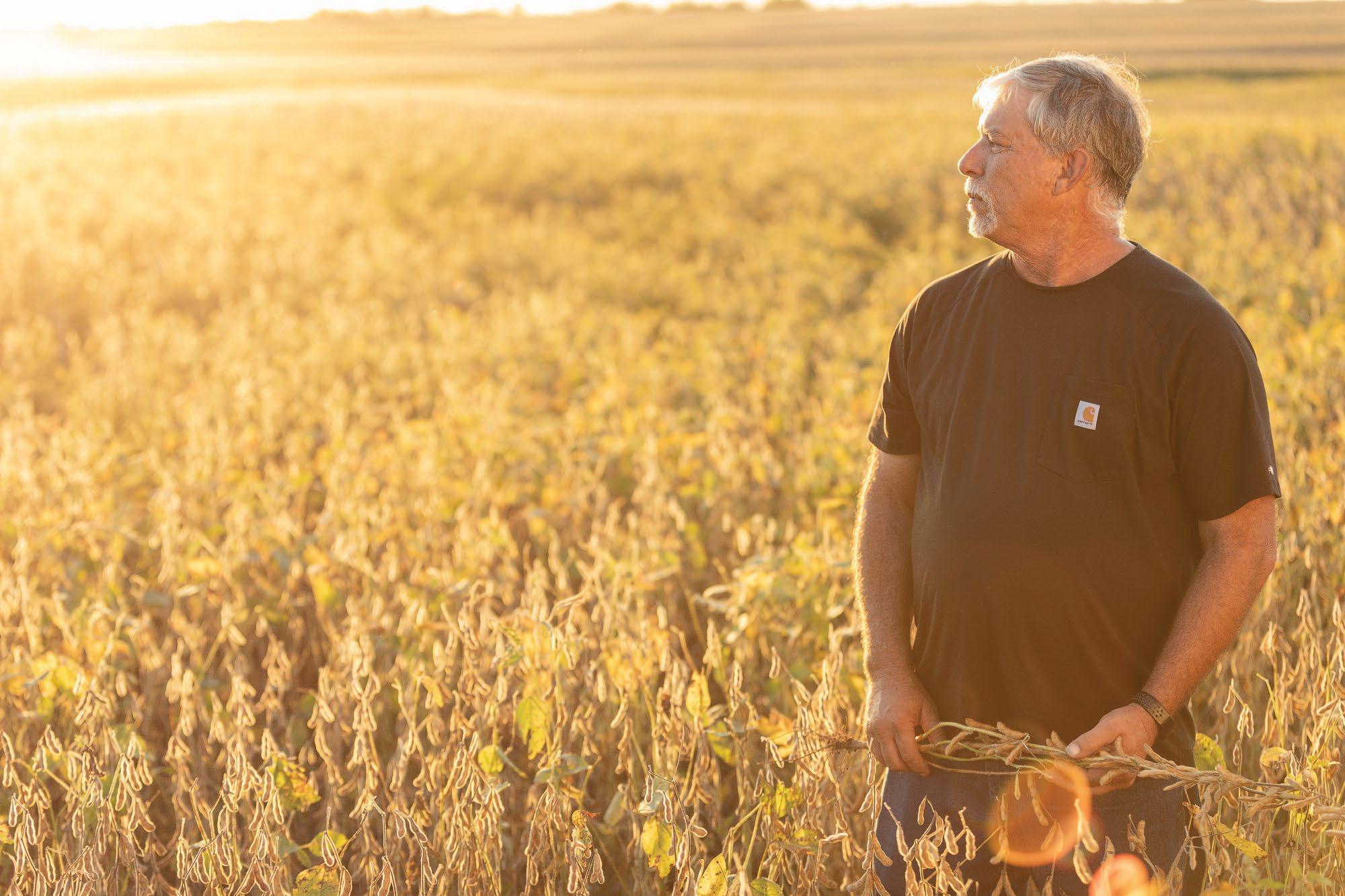















By Dusty Sonnenberg, CCA
As you are reading this, researchers at The Ohio State University are developing the technology you will be using on your farm tomorrow, thanks to your Ohio soybean check-off. From the use of artificial intelligence (AI) and scouting drones to more effective sprayer tip selection, your Ohio soybean checkoff is
effectiveness through the selection of the proper spray tips. He is also evaluating the characteristics of row spacing and plant population concerning effective spray coverage.
“We are trying to find a sweet spot so that we have the spray drift problems taken care of and by choosing the right nozzle, we can improve the efficiency of the
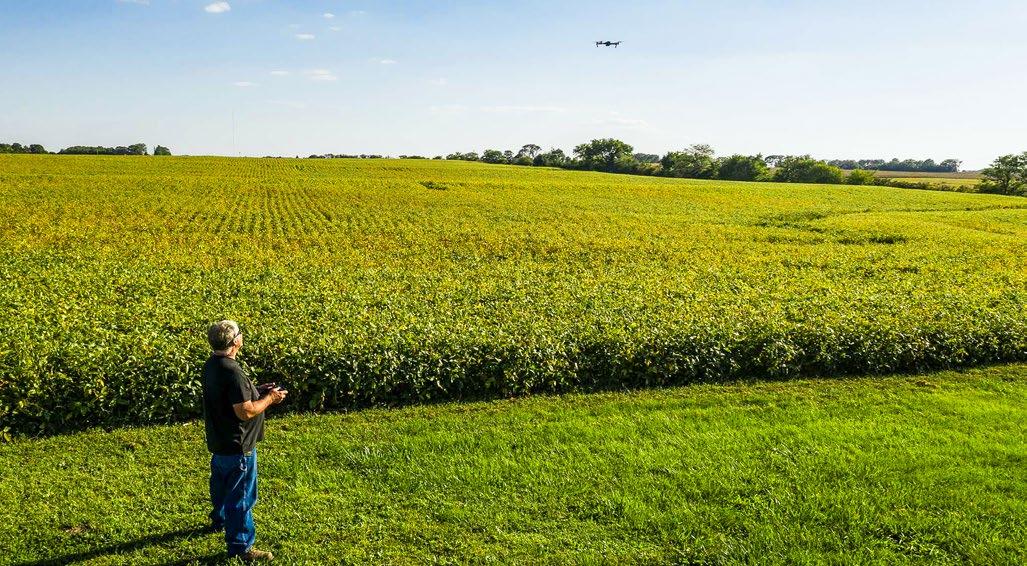
providing the funds to help these new technologies become reality.
Anyone who has sprayed a soybean crop with a fungicide or insecticide in mid-summer knows the challenge of getting the spray to penetrate the crop canopy. Variable plant height, environmental conditions such as wind speed and direction changes can impact the effectiveness of the application. Dr. Erdal Ozkan is a Professor in the Department of Agricultural Engineering at The Ohio State University. Dr. Ozkan is researching ways to reduce pesticide use and drift while increasing application
application. Disease issues are our first concern followed closely by insect pressure. Diseases and insects both like to reside in the lower part of the canopy,” said Dr. Ozkan.
Effectively getting the pesticide to penetrate the canopy with the correct droplet size is critical for a successful application. The research will include leaf area index measurements, spray drift assessments and droplet size measurements for the various nozzles, and airflow distribution and turbulence measurements inside the soybean canopy.
Farmers who have waded through a field of waist high tangled soybeans
to scout for insects and disease in the late July and early August humidity will appreciate new research in the area of unmanned aerial vehicle (UAV)-based remote sensing technology. Dr. Sami Khanal is an Assistant Professor in the Department of Agricultural Engineering at The Ohio State University. Her research focuses on agricultural remote sensing technologies. Using UAV’s to accurately assess soybean defoliation by insects and evaluating different UAV-mounted sensors. Dr. Khanal is developing models on how aerial observations correspond to actual damage in the field. This can save time and money while protecting yield.
The use of remote sensing technologies (such as satellites and drones) can provide timely and cost-effective methods for collecting and monitoring cover crop health. This information can be scaled to within a field or expanded to an entire watershed. The data collected is being used by researchers to identify field conditions that can maximize cereal rye cover crop biomass and promote soil health and agricultural productivity. Dr. Khanal is evaluating the usefulness of this imagery and developing models to estimate the cereal rye cover crop biomass and nutrient composition. “The satellite imagery is only visible and near infrared. The drone sensors create images that are very sensitive and multispectral,” said Khanal. This is important when it comes to accurately estimating crop height and biomass.
“The desired outcome of the project is to generate a very detailed map that allows us to pinpoint high and low cereal rye cover crop


biomass and correlate that with images of the soybean crop. We want to estimate the impact of cereal rye biomass on soybean productivity. The preliminary models have 87% accuracy,” said Khanal.
Dr. Khanal is also researching how drone-based solutions can aid in the identification of site-specific factors that contribute to high soybean yields. Khanal wants to provide high-resolution maps to identify areas that may need treated separately from the rest of the field to achieve those high yields.
“The ultimate goal is to develop AI models and a support tool that integrates data from drones and ground scouting that will be used to assist the farmer in decision making based on the cover crop biomass maps,” said Khanal. “With this information the farmer can create a planting prescription map or other management prescriptions.”
You may have been told to get your head out of the clouds when you were younger, but that is exactly where the technology is today. The use of artificial intelligence and small unmanned aerial systems (sUAS), also commonly known as drones, are utilizing the cloud and new sensor technology to build and enhance databases with imaging capabilities never seen before. The efficiency and improved accuracy of collecting information about the various forms of plant stress in the crop is greatly enhanced utilizing sUAS’s.
Dr. Christopher Stewart is an Associate Professor in the Computer Science and Engineering Department


at The Ohio State University. His research toward OpenPASS which is an open-source web and mobile application will allow users to automatically deploy softwarepiloted sUAS’s to scout for soybean health. OpenPASS uses advanced AI to pilot the sUAS’s and create crop health maps. A key innovative component of OpenPASS is the integration with high-performance computing resources.
“The main idea is to develop a unit of AI computing called the aerial scouting unit, which is the drone and the web front end to control the drone through very convenient interfaces with automatic AI computing running in the background,” said Stewart. “There is a lot of computation that has to be provisioned. It is more than just flying a drone and taking pictures. It is also doing the AI all in one package. We have a prototype that we are trying to get demos set-up and fly it this spring. We are very optimistic that this platform can be a tool that people can use for assessing soybean fields much more frequently and efficiently and then use that data in decision making.”
“Developing automatic and near real-time diagnostic capabilities is critical to cost-effective mitigation of soybean crop stress,” said Dr. Scott Shearer, Professor and Chair of the Department of Agricultural Engineering. Dr. Shearer is conducting research for automated remote crop stress detection and treatment as well as taking pictures and classifying
Pictured from left to right are:
Dr. Erdal Ozkan, Dr. Sami Khanal, Dr. Christopher Stewart, Dr. Scott Shearer
them using AI. Dr. Shearer is using sUAS’s to map and identify herbicide resistant weed escapes.
One aspect of the project is to develop protocols to guide the creation of image databases that will aid in machine learning and expand the capabilities of the existing AI green-on-green spot spraying technologies. Another aspect will create weed escape maps for direct spraying, and create protocols and technologies that will identify, map and eradicate weed escapes by using sUAS’s. First a scouting drone (sUAS) will survey and scout a field, then dispatch a second sUAS to treat the identified weed escapes. The goal is to make targeted direct chemical applications to eradicate the escapes.
“One of the things that we have learned with artificial intelligence is the more data you have, the more robust you can make the systems,” said Shearer. “The better job we can do acting on images depends on the number of images we have to build that robust data set. The bottom line is we have focused on using color images to assess crop stress. If you have 10 to 20 images, it is a novel thing looking at the response of the crop to a given stress. Scientifically, 10 to 20 images are not enough, 100 are not enough, 1,000 images are not enough to build a powerful data set. We need to be in the 100,000 to one million images to be enough. After that, it needs to be properly curated data that can be presented for processing and used to develop classification models. Once those are done, we can put it on a machine with AI capabilities in the field to utilize and act upon. That is when it becomes a win-win for a lot of people.” u
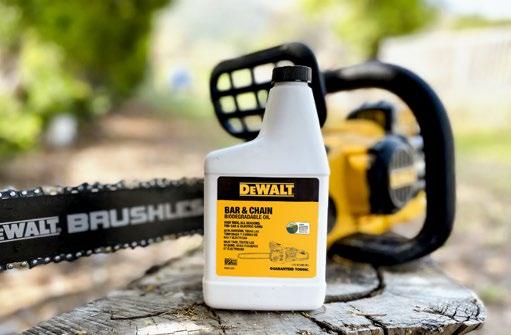
The next time you head to Home Depot, keep an eye out for a soy-based bar and chain oil that was developed with your soybean checkoff dollars. A project 2.5 years in the making, DEWALT recently announced their biodegradable chainsaw oil will be available at nearly 1,500 Home Depot locations across the country by the beginning of March. The oil is produced in the United States and is a USDA Certified Biobased Product. The new high-performance, bio-based formula is made from Ohio-grown soybean oil contributing to lower pollution output than conventional petroleum products.
"About 20 million gallons of bar and chain oil are discharged into the environment every year," said Dan Fitzgerald, director of product sustainability for Stanley Black & Decker. "The use of chainsaw oil is known as a 100 percent loss application since there is no way to capture and recycle the oil that is released into the environment. Creating a formula from renewable,
sustainable plant oil that is biodegradable is an environmentally responsible solution that DEWALT is proud to offer its customers."
The oil was developed through DEWALT’s partnership with Airable Research Lab, a business line of the Ohio Soybean Council and soybean checkoff. The lab, which is located in Delaware, Ohio, uses soybean checkoff dollars to focus entirely on the research and development of new soy-based products. The lab strives to create new markets and new demand for Ohio soybeans.
“It’s particularly rewarding to partner with a company like DEWALT. We know that the product will be adopted on a large scale, not just at niche companies but in homes and businesses across the country,” said Barry McGraw, chief laboratory officer at Airable. “My friends and family will use this bar and chain oil, and I can tell them Airable — and Ohio soybean farmers — played important roles in its development. That’s the kind
of product that will make a real difference, both to farmers and to the environment.”
Containing no petroleum-based oils or metal-based additives, the chainsaw oil is suitable for use around waterways and other environmentally sensitive areas. The formula also meets standards of the USDA's BioPreferred Program, which requires that federal agencies give preference to biobased products for federallyfunded programs and projects.
The commercial quality lubricant boasts a flash point above 500°F and a -15°F pour point for temperature stability in extreme conditions. In addition to optimal lubricity and wear protection, the oil is high tack to reduce high speed oil sling and is compatible with gas and batteryoperated chainsaws.
The biodegradable chainsaw oil was already available for purchase on Amazon, in Bomgaars Supply and Acme Tools stores, and through MAC TOOLS distributors. To learn more about the bar and chain oil, visit dewalt.com
The oil will be available at 48 Home Depot locations across Ohio, including:
Ashland
Ashtabula
Austintown
Beechmont
Boardman
Brice Road
Brooklyn Brunswick
Canal Winchester
Canton
Cleveland Ave
Cleveland Heights
Cross County (Colerain)
Cuyahoga Falls
East Hamilton
Elyria
Euclid
Fairlawn
Fields-Ertel
Forest Park
Harrison
Highland Heights
Lebanon
Macedonia
Maple Heights
Massillon
Medina
Mentor
Milford
Northeast Toledo
Niles
North Olmsted
Ontario
Pleasant Ridge
Rocky River
South Akron
Salem
Springfield
Streetsboro
Strongsville
Trotwood
West Toledo
Wadsworth
Washington Court House
West Broad
West Cleveland
Western Hills
Westgate
Zanesville
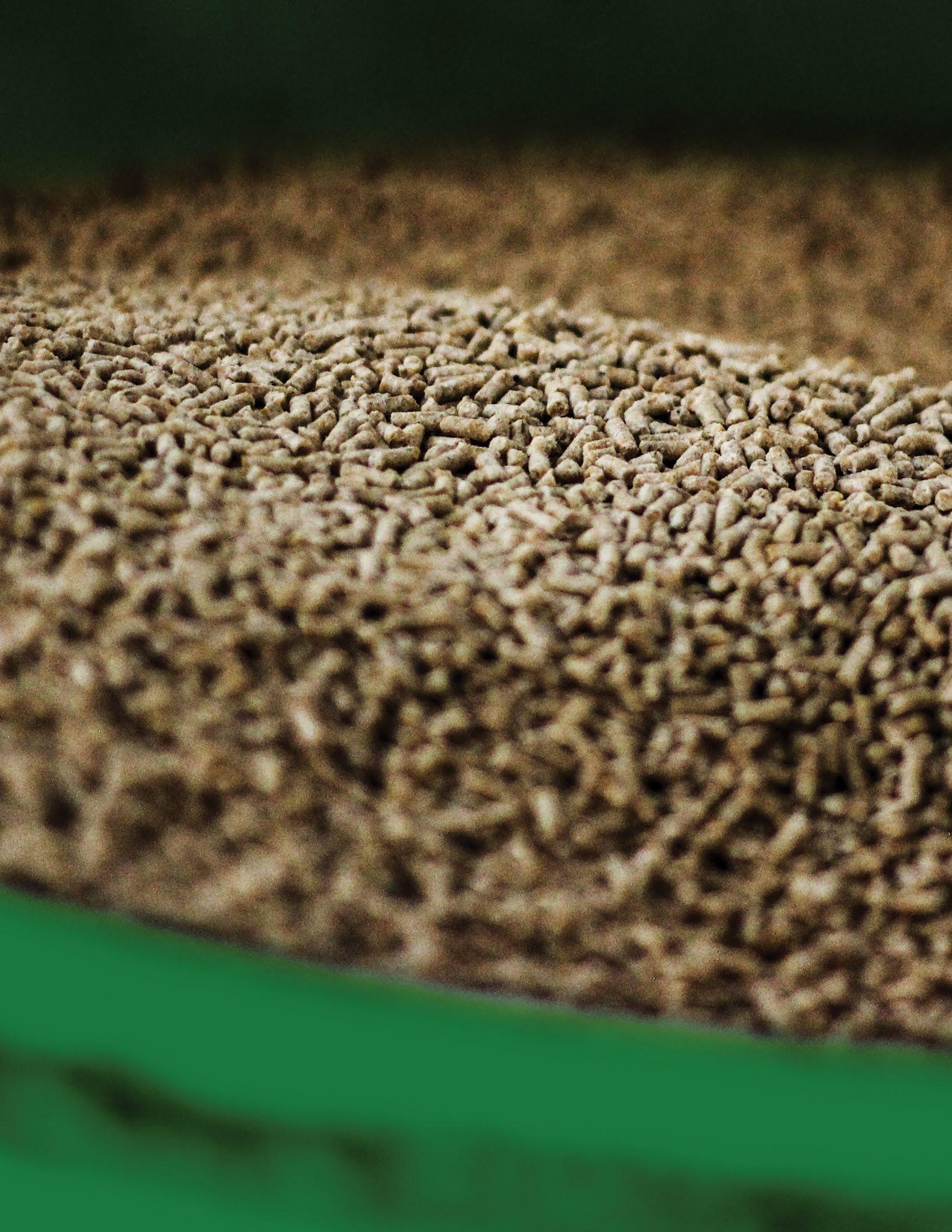


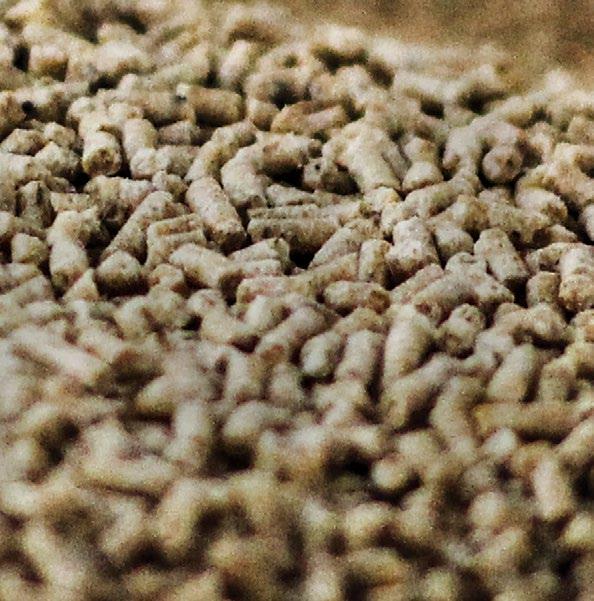
By Cameron Jodlowski, Precision Ag Specialist for RCIS
Spring has sprung and so has the excitement of a new crop season in Ohio. With all the excitement of a new crop, it is also a time to reflect on the last crop to see what can be improved with the new technology available. You have spent all winter seeing new, innovative ag tech at virtual events, farm shows and implement dealer events. Now you are ready to start applying this new technology into your operation. Before you start using some of the new precision ag and new ag tech tools, you may have to do a little setup work. With planting right around the corner, this set-up work can easily be concluded before the rush of the planting season begins, helping you to be more efficient and to utilize all of the planned ag tech this season.
Manually going around each field-to-map field boundaries may be a tedious task; however it sets up spring operations for success. Taking out waterways in the field and GPS tracking tree lines allows for correct placement of tillage and planting operations. Using an ATV or an UTV to set up field boundaries also allows for correct GPS offset in the field. Offsets are the basis of guidance lines for fields and as fields change, guidance lines change. Establishing boundaries allow for correct set-up files to be built and loaded into the monitor, supporting consistent naming structures for every operator on the farm.
A good set-up of the planter is not only going to save time in the spring, but it can help save your yield in the fall. Precision ag technologies on the planter

may be the most exciting, fastest growing and most innovative area of ag tech I see. From adding liquid fertilizer to the planter to optimizing seed to soil contact from sensors in every row, major innovation is happening on that planter. Setting up the planter and making sure all technology is working is essential to maximizing the use of ag tech on your farm. One thing I suggest is to make test passes with the planter to make sure all sensors are working, liquid is flowing and seed is coming out of the planter. Additionally, take the time to calibrate each row of the planter by running seed through. Calibrating your planter early will ensure that data collected is correct and seed is flowing out of each row.
One of my favorite things to talk to growers about is in-field trials — precision ag is essential to measuring the success of your field trials. To prepare, create and load any prescription files to monitors for in-field trials. Create certain zones in farm management systems to gather information required for trials. Ag tech is advancing in the form of new in-field innovations such as microbes and biological products that are delivering different forms of nutrients needed for crops. It is great to consider the types of trials you want to run and plan for those trials in the beginning of the season, then executing on them before planting.
Planting is only the start of the precision ag journey for a grower. Considering how you want to use the post-planting data is essential. One of my favorite applications of precision ag is to use post planting to see if any field spots were missed or may need to be replanted due to planting errors or natural disaster events. Additionally, using your planting data for crop insurance acreage reporting to your agent is a great ag tech tool for growers, allowing you to insure only what you are planting. It can help maximize the effectiveness of your crop insurance policy.
Precision ag presents many innovations when it comes to in-field management decisions, especially during planting. In farming operations, I often see two different types of operators: one skilled with tech and another an early adopter. Creating a game plan before the season starts, defining how to execute ag tech decisions such as downforce reading, good ride measurements and seed singulation will help result in more informed decisions in the cab. I recommend reviewing how fields are set-up and showing operators how to capture data in the field as part of your preseason game plan. u
By Julia Brown, OSC Director of Communications
Ididn’t grow up on a farm. My grandparents grew up on grain and livestock operations, but had moved off the farm long before I was around. Before I started working for the Ohio Soybean Council, I had a very romanticized version of farming in my head — a farmer in overalls with a pitchfork standing in front of a red barn. I was naïve. I had no idea how technologically advanced agriculture was and was genuinely shocked to discover that ag is on the cutting edge of many advances in technology.
One of the most important (and fun!) parts of my job is talking to consumers about modern farming. At our booths, which are usually set up at farmers markets or sporting events, we have a very brief time to share a little bit about soybean farming with passersby. Consistently, the thing that shocks people the most is when we talk about the technology that is used to grow row crops.
People are amazed to know that the same drone they fly in their backyard is helping farmers survey their fields for yield robbers, and will hopefully one day be used to precisely apply fertilizer and pesticides. They are shocked to discover that the same technology that helps their Tesla drive itself down the road is already helping farmers to have perfect rows when planting and harvesting.
According to the National Science Foundation, almost one in four Americans are employed in a STEM (science, technology,

engineering and mathematics) field. However, the U.S. Bureau of Labor Statistics claims that only an extremely small percentage of those STEM workers are ag engineers, though the field is expected to grow by 6 percent over the next 10 years, more than most occupations. As we continue to grow ag’s involvement with and reliance on these new technologies, it is also imperative that we grow a workforce of people to help develop and maintain these new tools.
Although my work involves communicating with consumers about ag technology, the Ohio Soybean Council’s GrowNextGen program is doing real work in grade school classrooms to get students excited about and interested in STEM careers within agriculture. GrowNextGen provides free resources and lessons to teachers that help them teach their required STEM material through an ag lens, often providing
Students learn to fly drones with GrowNextGen at Graham Middle School in Champaign County.
students with their first real look at how agriculture is leading the way in technology and science. I know that working with new ag technology is not always a walk in the park, but these new tools are meant to make farming more efficient. If you enjoy any of the convenience and ease that comes with things like autosteer and precision nutrient application, I encourage you to share the resources available at GrowNextGen.org with a teacher in your life. Help us to share the amazing technological advancements and career opportunities that are available in agriculture. Help us to build the next generation of ag tech that can make our industry more efficient and profitable. u

“Researching




-ALEX SHAND, INNOVATION ENGINEER
AIRABLE RESEARCH LAB















